
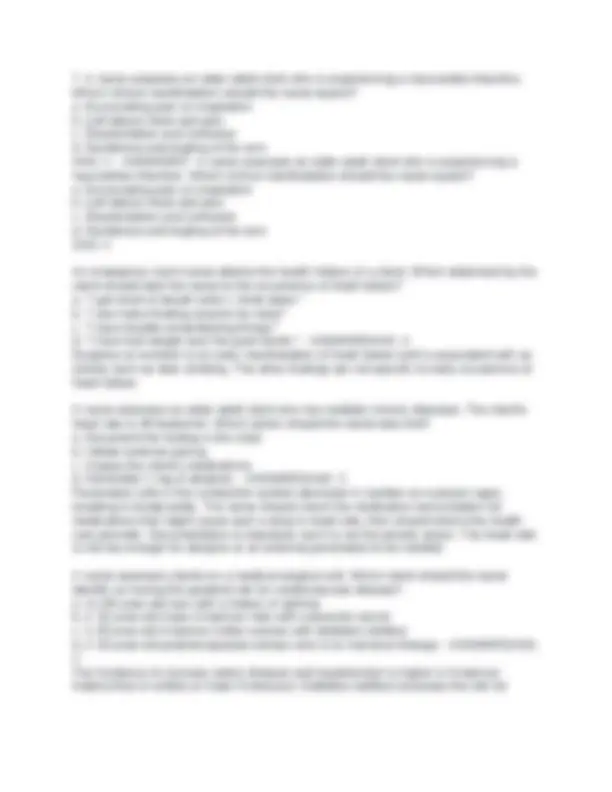
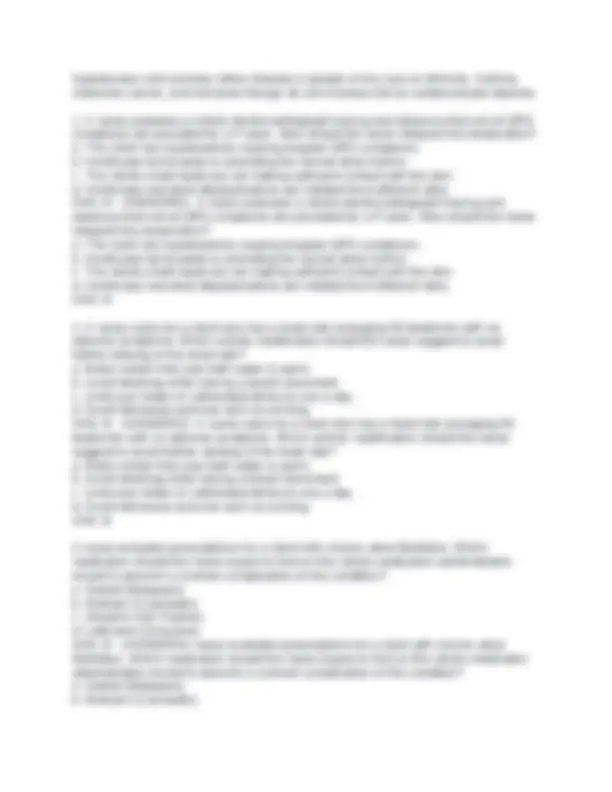
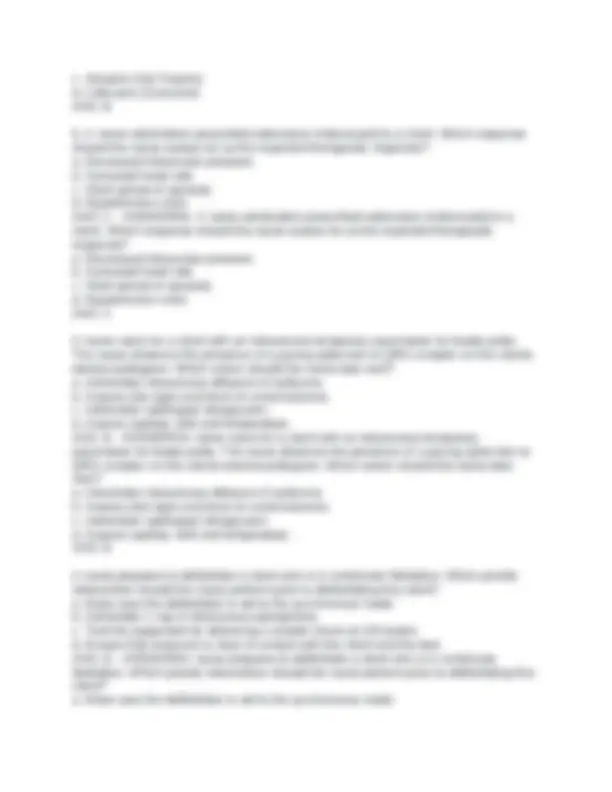
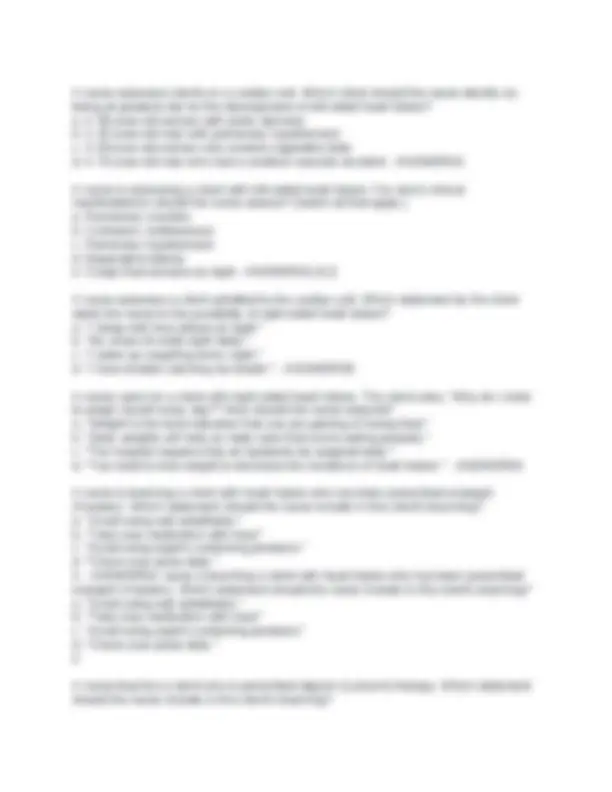
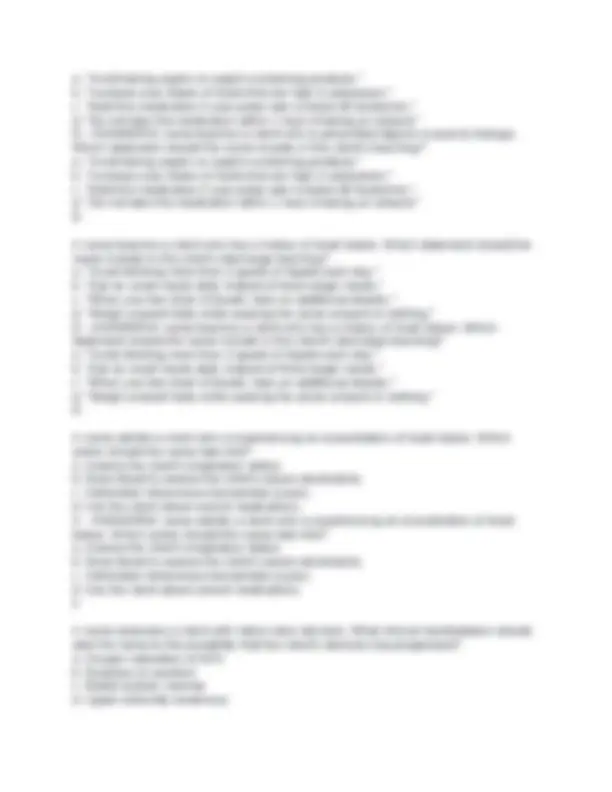
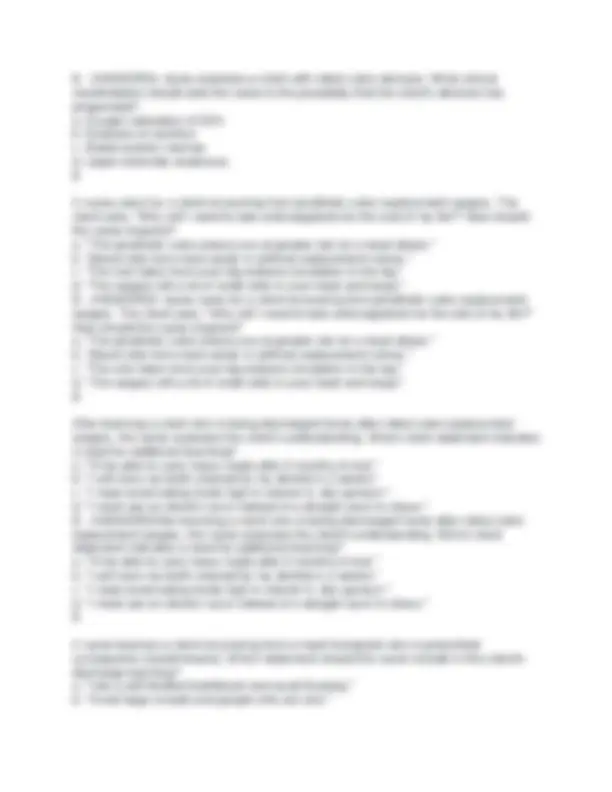
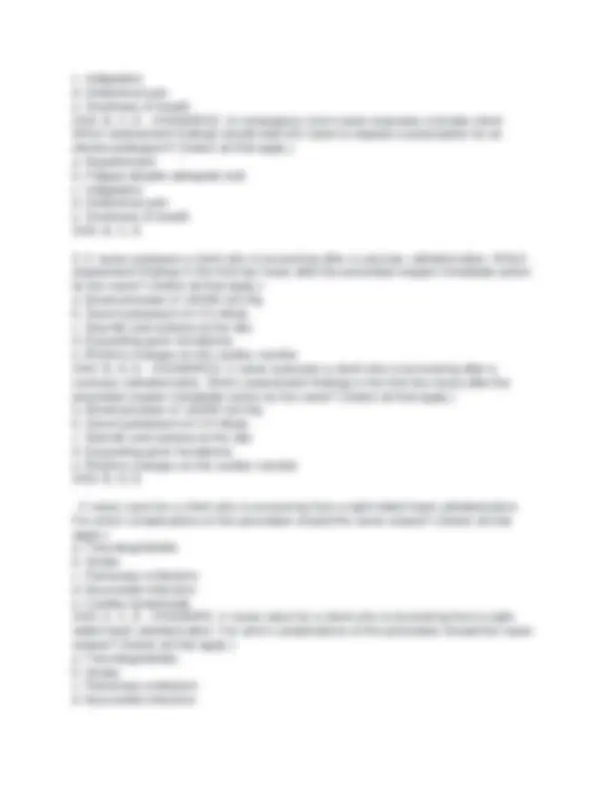
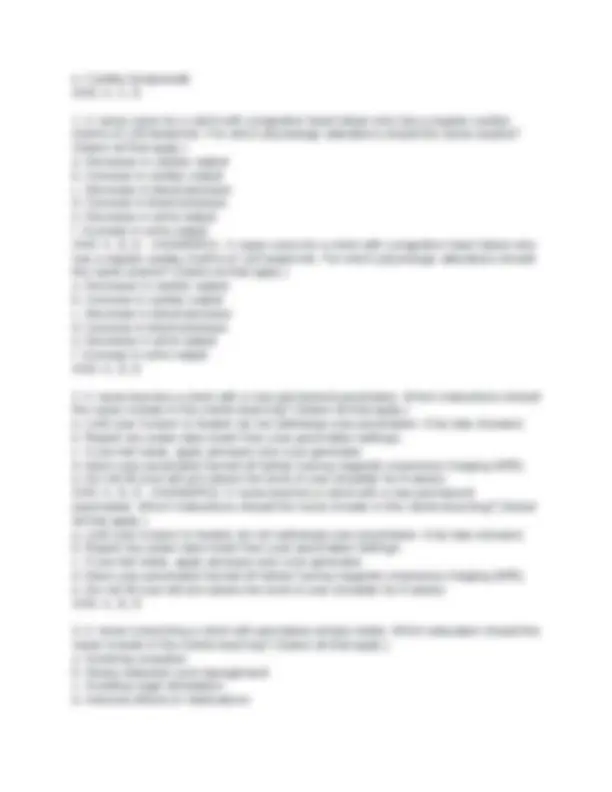
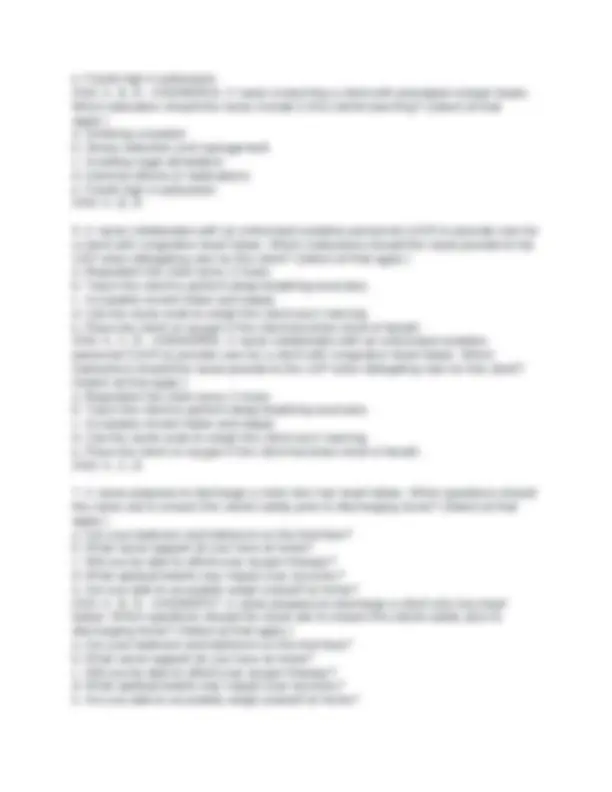


Study with the several resources on Docsity

Earn points by helping other students or get them with a premium plan


Prepare for your exams
Study with the several resources on Docsity

Earn points to download
Earn points by helping other students or get them with a premium plan
Community
Ask the community for help and clear up your study doubts
Discover the best universities in your country according to Docsity users
Free resources
Download our free guides on studying techniques, anxiety management strategies, and thesis advice from Docsity tutors
This resource provides multiple-choice questions and answers covering essential nursing concepts, including cardiovascular disease, heart failure, and medication administration. It is designed to help students prepare for nursing exams and practice their knowledge in a format similar to popular learning platforms.
Typology: Exams
1 / 16

This page cannot be seen from the preview
Don't miss anything!










A nurse assesses a client who had a myocardial infarction and is hypotensive. Which additional assessment finding should the nurse expect? a. Heart rate of 120 beats/min b. Cool, clammy skin c. Oxygen saturation of 90% d. Respiratory rate of 8 breaths/min" - ANSWERSANS: A A nurse assesses a client after administering a prescribed beta blocker. Which assessment should the nurse expect to find? a. Blood pressure increased from 98/42 mm Hg to 132/60 mm Hg b. Respiratory rate decreased from 25 breaths/min to 14 breaths/min c. Oxygen saturation increased from 88% to 96% d. Pulse decreased from 100 beats/min to 80 beats/min - ANSWERSANS: D An emergency department nurse triages clients who present with chest discomfort. Which client should the nurse plan to assess first? a. A 42-year-old female who describes her pain as a dull ache with numbness in her fingers b. A 49-year-old male who reports moderate pain that is worse on inspiration c. A 53-year-old female who reports substernal pain that radiates to her abdomen d. A 58-year-old male who describes his pain as intense stabbing that spreads across his chest ANS: D - ANSWERSAn emergency department nurse triages clients who present with chest discomfort. Which client should the nurse plan to assess first? a. A 42-year-old female who describes her pain as a dull ache with numbness in her fingers b. A 49-year-old male who reports moderate pain that is worse on inspiration c. A 53-year-old female who reports substernal pain that radiates to her abdomen d. A 58-year-old male who describes his pain as intense stabbing that spreads across his chest ANS: D
hypertension and coronary artery disease in people of any race or ethnicity. Asthma, colorectal cancer, and hormone therapy do not increase risk for cardiovascular disease.
c. Atropine (Sal-Tropine) d. Lidocaine (Xylocaine) ANS: B
ANS: D - ANSWERS18. A nurse assesses a clients electrocardiogram (ECG) and observes the reading shown below: How should the nurse document this clients ECG strip? a. Ventricular tachycardia b. Ventricular fibrillation c. Sinus rhythm with premature atrial contractions (PACs) d. Sinus rhythm with premature ventricular contractions (PVCs) ANS: D
A nurse assesses clients on a cardiac unit. Which client should the nurse identify as being at greatest risk for the development of left-sided heart failure? a. A 36-year-old woman with aortic stenosis b. A 42-year-old man with pulmonary hypertension c. A 59-year-old woman who smokes cigarettes daily d. A 70-year-old man who had a cerebral vascular accident - ANSWERSA A nurse is assessing a client with left-sided heart failure. For which clinical manifestations should the nurse assess? (Select all that apply.) a. Pulmonary crackles b. Confusion, restlessness c. Pulmonary hypertension d. Dependent edema e. Cough that worsens at night - ANSWERSA,B,E A nurse assesses a client admitted to the cardiac unit. Which statement by the client alerts the nurse to the possibility of right-sided heart failure? a. "I sleep with four pillows at night." b. "My shoes fit really tight lately." c. "I wake up coughing every night." d. "I have trouble catching my breath." - ANSWERSB A nurse cares for a client with right-sided heart failure. The client asks, "Why do I need to weigh myself every day?" How should the nurse respond? a. "Weight is the best indication that you are gaining or losing fluid." b. "Daily weights will help us make sure that you're eating properly." c. "The hospital requires that all inpatients be weighed daily." d. "You need to lose weight to decrease the incidence of heart failure." - ANSWERSA A nurse is teaching a client with heart failure who has been prescribed enalapril (Vasotec). Which statement should the nurse include in this client's teaching? a. "Avoid using salt substitutes." b. "Take your medication with food." c. "Avoid using aspirin-containing products." d. "Check your pulse daily." A - ANSWERSA nurse is teaching a client with heart failure who has been prescribed enalapril (Vasotec). Which statement should the nurse include in this client's teaching? a. "Avoid using salt substitutes." b. "Take your medication with food." c. "Avoid using aspirin-containing products." d. "Check your pulse daily." A A nurse teaches a client who is prescribed digoxin (Lanoxin) therapy. Which statement should the nurse include in this client's teaching?
B - ANSWERSA nurse assesses a client with mitral valve stenosis. What clinical manifestation should alert the nurse to the possibility that the client's stenosis has progressed? a. Oxygen saturation of 92% b. Dyspnea on exertion c. Muted systolic murmur d. Upper extremity weakness B A nurse cares for a client recovering from prosthetic valve replacement surgery. The client asks, "Why will I need to take anticoagulants for the rest of my life?" How should the nurse respond? a. "The prosthetic valve places you at greater risk for a heart attack." b. "Blood clots form more easily in artificial replacement valves." c. "The vein taken from your leg reduces circulation in the leg." d. "The surgery left a lot of small clots in your heart and lungs." B - ANSWERSA nurse cares for a client recovering from prosthetic valve replacement surgery. The client asks, "Why will I need to take anticoagulants for the rest of my life?" How should the nurse respond? a. "The prosthetic valve places you at greater risk for a heart attack." b. "Blood clots form more easily in artificial replacement valves." c. "The vein taken from your leg reduces circulation in the leg." d. "The surgery left a lot of small clots in your heart and lungs." B After teaching a client who is being discharged home after mitral valve replacement surgery, the nurse assesses the client's understanding. Which client statement indicates a need for additional teaching? a. "I'll be able to carry heavy loads after 6 months of rest." b. "I will have my teeth cleaned by my dentist in 2 weeks." c. "I must avoid eating foods high in vitamin K, like spinach." d. "I must use an electric razor instead of a straight razor to shave." B - ANSWERSAfter teaching a client who is being discharged home after mitral valve replacement surgery, the nurse assesses the client's understanding. Which client statement indicates a need for additional teaching? a. "I'll be able to carry heavy loads after 6 months of rest." b. "I will have my teeth cleaned by my dentist in 2 weeks." c. "I must avoid eating foods high in vitamin K, like spinach." d. "I must use an electric razor instead of a straight razor to shave." B A nurse teaches a client recovering from a heart transplant who is prescribed cyclosporine (Sandimmune). Which statement should the nurse include in this client's discharge teaching? a. "Use a soft-bristled toothbrush and avoid flossing." b. "Avoid large crowds and people who are sick."
c. "Change positions slowly to avoid hypotension." d. "Check your heart rate before taking the medication." B - ANSWERSA nurse teaches a client recovering from a heart transplant who is prescribed cyclosporine (Sandimmune). Which statement should the nurse include in this client's discharge teaching? a. "Use a soft-bristled toothbrush and avoid flossing." b. "Avoid large crowds and people who are sick." c. "Change positions slowly to avoid hypotension." d. "Check your heart rate before taking the medication." B A nurse cares for a client with end-stage heart failure who is awaiting a transplant. The client appears depressed and states, "I know a transplant is my last chance, but I don't want to become a vegetable." How should the nurse respond? a. "Would you like to speak with a priest or chaplain?" b. "I will arrange for a psychiatrist to speak with you." c. "Do you want to come off the transplant list?" d. "Would you like information about advance directives?" D - ANSWERSA nurse cares for a client with end-stage heart failure who is awaiting a transplant. The client appears depressed and states, "I know a transplant is my last chance, but I don't want to become a vegetable." How should the nurse respond? a. "Would you like to speak with a priest or chaplain?" b. "I will arrange for a psychiatrist to speak with you." c. "Do you want to come off the transplant list?" d. "Would you like information about advance directives?" D A nurse assesses a client who has a history of heart failure. Which question should the nurse ask to assess the extent of the client's heart failure? a. "Do you have trouble breathing or chest pain?" b. "Are you able to walk upstairs without fatigue?" c. "Do you awake with breathlessness during the night?" d. "Do you have new-onset heaviness in your legs?" B - ANSWERSA nurse assesses a client who has a history of heart failure. Which question should the nurse ask to assess the extent of the client's heart failure? a. "Do you have trouble breathing or chest pain?" b. "Are you able to walk upstairs without fatigue?" c. "Do you awake with breathlessness during the night?" d. "Do you have new-onset heaviness in your legs?" B A nurse cares for an older adult client with heart failure. The client states, "I don't know what to do. I don't want to be a burden to my daughter, but I can't do it alone. Maybe I should die." How should the nurse respond? a. "Would you like to talk more about this?" b. "You are lucky to have such a devoted daughter."
c. Indigestion d. Abdominal pain e. Shortness of breath ANS: B, C, E - ANSWERS2. An emergency room nurse assesses a female client. Which assessment findings should alert the nurse to request a prescription for an electrocardiogram? (Select all that apply.) a. Hypertension b. Fatigue despite adequate rest c. Indigestion d. Abdominal pain e. Shortness of breath ANS: B, C, E
e. Cardiac tamponade ANS: A, C, E